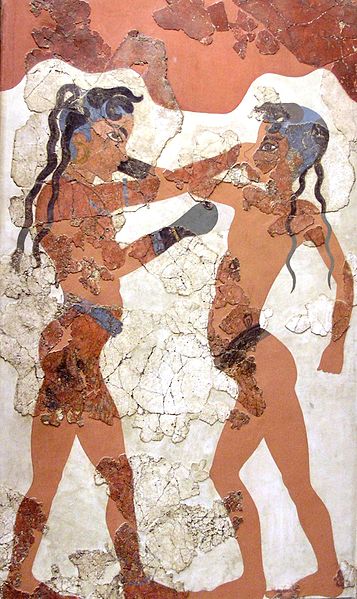
Popular belief about the Minoans had it so far that the first urban civilization in Europe was largely peaceful and organized in such a way that war was not an important element to their development and life, which turned the prehistoric civilization into a unique and utopic role model for modern societies. However, a recent research paper from the University of Sheffield, UK, suggests otherwise. According to leading researcher Dr. Barry Molloy from the Department of Archaeology of the University, war was actually a defining characteristic of the Minoan society, whose martial traditions and weaponry were passed on to the Mycenaeans and dominated Europe until the Middle Ages.
“The study shows that the activities of warriors included such diverse things as public displays of bull-leaping, boxing contests, wrestling, hunting, sparring and duelling. Ideologies of war are shown to have permeated religion, art, industry, politics and trade, and the social practices surrounding martial traditions were demonstrably a structural part of how this society evolved and how they saw themselves” Molloy commented.
According to the University’s official press release, Molloy found a “staggering” amount of violence in the symbolic grammar and material remains from prehistoric Crete during his research. Weapons and warrior culture were materialized variously in sanctuaries, graves, domestic units and hoards. It could also be found in portable media intended for use during social interactions, for example, administration, feasting, or personal adornment.
The paper analyzes war as a social process that was shaping the everyday lives of the Minoan people back then. “The social and institutional components of war impacted on settlement patterns, landscape exploitation, technological and trade networks, religious practices, art, administration and more, so that war was indirectly a constant factor in shaping the daily lives of people in prehistoric Crete…understanding the social aspects of war ‘beyond the battle’ is essential if we are to better understand how elites manipulated economics, religion and violence in controlling their worlds. By identifying the material results of warrior life-ways in all of their disparity and disorder, we gain insight into what war meant in ancient Crete” Molloy explained.
The research paper, entitled Martial Minoans? War as social process, practice and event in Bronze Age Crete, is published in the Annual of the British School in Athens and is available at: Cambridge Journal
See all the latest news from Greece and the world at Greekreporter.com. Contact our newsroom to report an update or send your story, photos and videos. Follow GR on Google News and subscribe here to our daily email!



